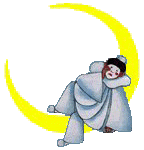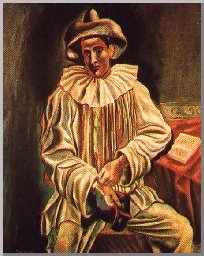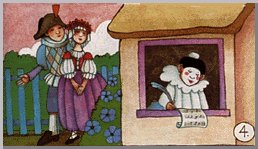
|
|





|








Pierrot is a familiar figure in traditional mime, has a whitened face, voluminous white garments with large buttons, and a pointed hat. The figure originated as Pedrolino, a wily servant in the commedia dell'arte; the actor Giuseppe Giaratone, who played Pierrot in a 1665 production of Moliere's Don Juan, added the costume. The 19th-century mime Jean Deburau transformed Pierrot into the comic yet pathetic character recognized today. Pierrot is also the protagonist of a French song, Au clair de la lune.
| La commedia dell'arte |
Pierrot J.G. Deburau Au clair de la lune
|
Actors studied a single role, becoming identified with it on and off stage. They were trained in mime and acrobatics, and studied Italian dialects and the classics for use in monologues. Though some speeches were memorized, most were improvised on stage. Often the plot was interrupted by lazzi, which consisted of comic business, jokes, and witty byplay performed by the zanni. Ensemble playing was essential.
| Pablo Picasso's Pierrot |
|
Several possible origins of the commedia have been suggested: Roman
Atellan farces, whose characters resemble those of the commedia; the
mimes and farces of the medieval theater; and Eastern mimes and puppet
drama from Constantinople. More recent scholarship suggests that it
emerged from early 16th-century folk drama, carnivals, festivals and
mountebank shows. Ruzzante (Angelo Beolco, 1502-42) has been
considered the father of the commedia, but the plays that his troupe
performed at carnivals, though similar in style, were only partially
improvised.
|
 |
The plays of Carlo Goldoni and Carlo Gozzi brought the commedia
to an end. At first they improvised and used commedia characters and
masks, but they later developed written comedies, literary in style,
dispensing with masks and reducing the number of commedia characters.
The commedia continues its influence in
Charlie Chaplin's
![]() comedies, Marcel Marceau's mimes and English Christmas pantomime.
comedies, Marcel Marceau's mimes and English Christmas pantomime.
| J. G. Deburau |
Pierrot Commedia dell'arte Au clair de la lune
|
| Au Clair de la Lune |
Pierrot Commedia dell'arte J.G. Deburau
|
|
1. Au clair de la lune, Mon ami Pierrot, Prête-moi ta plume Pour écrire un mot. Ma chandelle est morte, Je n'ai plus de feu. Ouvre-moi ta porte Pour l'amour de Dieu!
2.
3.
4.
|
|
Go to the top of the page
